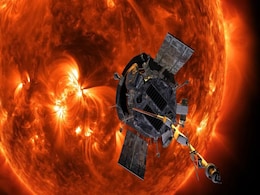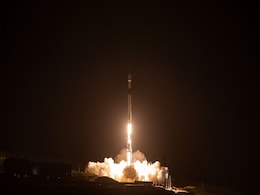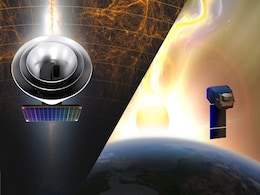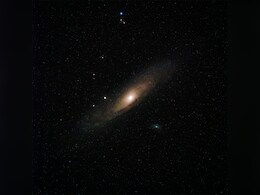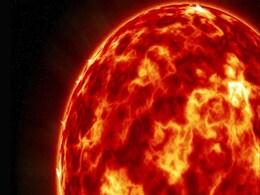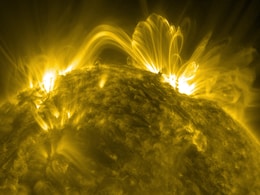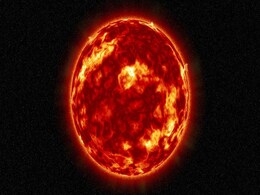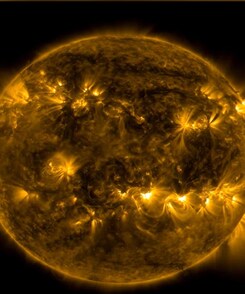Nasa Sun
- All
- News
- Videos
- Web Stories
-

NASA Hubble Space Telescope Helps Confirm the First Solitary Black Hole
- Friday April 18, 2025
- Written by Gadgets 360 Staff
In the Sagittarius constellation, a lone and first-ever solitary black hole has been discovered by a team of scientists. Although the discovery began in the year 2011, the observations have confirmed it recently. The size of this black hole is as massive as seven times of the sun. Despite the conflicts and differences of observations by another tea...
-
 www.gadgets360.com
www.gadgets360.com
-

NASA’s Parker Solar Probe Completes Second Close Flyby of the Sun at Record Speed
- Monday April 7, 2025
- Written by Gadgets 360 Staff
NASA’s Parker Solar Probe completed a close flyby of the Sun on March 22, travelling at 692,000 kilometres per hour and approaching within 6.1 million kilometres of the solar surface. The mission, designed to study solar winds and space weather, received a healthy signal back on March 25. The team, including NASA and Johns Hopkins APL experts, ha...
-
 www.gadgets360.com
www.gadgets360.com
-

Partial Solar Eclipse of March 2025: Satellite Images to Show Moon’s Shadow
- Saturday March 29, 2025
- Written by Gadgets 360 Staff
A partial solar eclipse will take place on March 29, 2025, visible across parts of Europe, Africa, and North America. The event will reach its peak in Nunavik, Canada, where 94% of the sun will be covered at sunrise. From space, weather satellites like GOES-16 and Himawari will capture images of the moon’s shadow. The International Space Station ...
-
 www.gadgets360.com
www.gadgets360.com
-

SpaceX Falcon 9 Successfully Deploys NASA’s SPHEREx Telescope and PUNCH Probes
- Thursday March 13, 2025
- Written by Gadgets 360 Staff
NASA’s SPHEREx and PUNCH missions have successfully launched aboard a SpaceX Falcon 9 rocket from Vandenberg Space Force Base in California. SPHEREx will map the entire celestial sky in 102 infrared colours, while PUNCH will study the transition of the sun’s corona into the solar wind. The two-year missions aim to deepen our understanding of th...
-
 www.gadgets360.com
www.gadgets360.com
-

"It's A New Dawn": Blue Ghost Lander Captures 1st Sunrise On Moon
- Tuesday March 4, 2025
- World News | Edited by NDTV News Desk
NASA shared the breathtaking image on X on Monday, showing the moon's uneven surface with deep craters and the Sun's rays beaming brightly in the distance.
-
 www.ndtv.com
www.ndtv.com
-

NASA’s New Missions Will Map the Sun and the Cosmos
- Tuesday March 4, 2025
- Written by Gadgets 360 Staff
NASA is set to launch two major missions, PUNCH and SPHEREx, aboard a SpaceX Falcon 9 from Vandenberg Space Force Base on March 2. PUNCH, a four-satellite system, will study the sun’s corona and space weather, while SPHEREx will create infrared maps of the cosmos to study galaxy evolution and cosmic history. These missions will contribute to a de...
-
 www.gadgets360.com
www.gadgets360.com
-

Over 1 Million Interstellar Objects Could Be Hidden in Our Solar System
- Tuesday February 18, 2025
- Written by Gadgets 360 Staff
A new study reveals that more than 1 million interstellar objects, each larger than the Statue of Liberty, may be residing in the Oort Cloud. These objects, believed to have originated from the Alpha Centauri system, were captured by the Sun’s gravity and are now part of our solar system. Unlike fast-moving interstellar visitors, these objects re...
-
 www.gadgets360.com
www.gadgets360.com
-

NASA’s PUNCH Mission Set to Track the Sun’s Corona and Solar Wind in 3D
- Friday February 7, 2025
- Written by Gadgets 360 Staff
NASA’s PUNCH mission, set for launch on Feb 27, will deploy four satellites to study the transition between the sun’s corona and the solar wind. The mission aims to improve understanding of space weather by capturing 3D images, helping predict solar storms with greater accuracy. The data will also complement NASA’s Parker Solar Probe, offerin...
-
 www.gadgets360.com
www.gadgets360.com
-

Comet ATLAS Offers Stunning Display as It Nears the Sun
- Friday January 24, 2025
- Written by Gadgets 360 Staff
Comet C/2024 G3 (ATLAS) recently passed within 8 million miles of the Sun, capturing the attention of astronomers. Observed by NASA and ESA’s Solar and Heliospheric Observatory (SOHO), the comet’s tail extended dramatically as it encountered intense solar winds, providing a unique opportunity to study the Sun’s impact on comets. The event, wh...
-
 www.gadgets360.com
www.gadgets360.com
-

Study Finds Coronal Loop Flickers Could Predict Solar Flares Hours in Advance
- Friday January 17, 2025
- Written by Gadgets 360 Staff
NASA's Solar Dynamics Observatory has revealed a potential breakthrough in predicting solar flares. Scientists observed brightness fluctuations in coronal loops—plasma structures in the Sun's atmosphere—that intensify hours before solar flares occur. This discovery, with a prediction accuracy of 60–80%, may provide 2–6 hours of advance warn...
-
 www.gadgets360.com
www.gadgets360.com
-

James Webb Space Telescope Detects Supernova From 11.4 Billion Years Ago
- Friday January 17, 2025
- Written by Gadgets 360 Staff
Astronomers using the James Webb Space Telescope (JWST) have identified AT 2023adsv, a supernova that occurred 11.4 billion years ago. This stellar explosion, from a star 20 times the size of the Sun, offers a glimpse into the early universe's unique stellar evolution. Part of the JWST Advanced Deep Extragalactic Survey, the event highlights how th...
-
 www.gadgets360.com
www.gadgets360.com
-

ESA Uses Solar Orbiter to Turn Solar Flares into Sound, Offering New Insights
- Thursday January 16, 2025
- Written by Gadgets 360 Staff
The European Space Agency (ESA), in collaboration with NASA, has used data from the Solar Orbiter mission to convert solar flares into audible sound. By mapping solar flare data into blue circles and pairing them with tones, a new way to experience solar activity has been created. This process is linked to the sun’s 11-year solar cycle, with curr...
-
 www.gadgets360.com
www.gadgets360.com
-

What Happened to the Apollo Flags Left on the Moon?
- Thursday January 16, 2025
- Written by Gadgets 360 Staff
The flags planted by Apollo astronauts on the moon are likely in poor condition due to harsh lunar conditions. Exposure to intense sunlight and micrometeoroid impacts likely caused the degradation of the flags. Although they may be brittle and faded, these flags remain powerful symbols of the achievements of the Apollo missions. Experts have specul...
-
 www.gadgets360.com
www.gadgets360.com
-

Solar Missions in 2025: Heliophysics Projects and Spacecrafts That Will Study the Sun
- Saturday January 4, 2025
- Written by Gadgets 360 Staff
The study of the sun, its activity, and effects across the solar system will advance in 2025. With Solar Cycle 25 peaking, six NASA missions planned, and new research priorities outlined, scientists are poised to address long-standing questions about solar dynamics and their impacts. Missions such as IMAP, ESCAPADE, and PUNCH will investigate solar...
-
 www.gadgets360.com
www.gadgets360.com
-

NASA Hubble Space Telescope Helps Confirm the First Solitary Black Hole
- Friday April 18, 2025
- Written by Gadgets 360 Staff
In the Sagittarius constellation, a lone and first-ever solitary black hole has been discovered by a team of scientists. Although the discovery began in the year 2011, the observations have confirmed it recently. The size of this black hole is as massive as seven times of the sun. Despite the conflicts and differences of observations by another tea...
-
 www.gadgets360.com
www.gadgets360.com
-

NASA’s Parker Solar Probe Completes Second Close Flyby of the Sun at Record Speed
- Monday April 7, 2025
- Written by Gadgets 360 Staff
NASA’s Parker Solar Probe completed a close flyby of the Sun on March 22, travelling at 692,000 kilometres per hour and approaching within 6.1 million kilometres of the solar surface. The mission, designed to study solar winds and space weather, received a healthy signal back on March 25. The team, including NASA and Johns Hopkins APL experts, ha...
-
 www.gadgets360.com
www.gadgets360.com
-

Partial Solar Eclipse of March 2025: Satellite Images to Show Moon’s Shadow
- Saturday March 29, 2025
- Written by Gadgets 360 Staff
A partial solar eclipse will take place on March 29, 2025, visible across parts of Europe, Africa, and North America. The event will reach its peak in Nunavik, Canada, where 94% of the sun will be covered at sunrise. From space, weather satellites like GOES-16 and Himawari will capture images of the moon’s shadow. The International Space Station ...
-
 www.gadgets360.com
www.gadgets360.com
-

SpaceX Falcon 9 Successfully Deploys NASA’s SPHEREx Telescope and PUNCH Probes
- Thursday March 13, 2025
- Written by Gadgets 360 Staff
NASA’s SPHEREx and PUNCH missions have successfully launched aboard a SpaceX Falcon 9 rocket from Vandenberg Space Force Base in California. SPHEREx will map the entire celestial sky in 102 infrared colours, while PUNCH will study the transition of the sun’s corona into the solar wind. The two-year missions aim to deepen our understanding of th...
-
 www.gadgets360.com
www.gadgets360.com
-

"It's A New Dawn": Blue Ghost Lander Captures 1st Sunrise On Moon
- Tuesday March 4, 2025
- World News | Edited by NDTV News Desk
NASA shared the breathtaking image on X on Monday, showing the moon's uneven surface with deep craters and the Sun's rays beaming brightly in the distance.
-
 www.ndtv.com
www.ndtv.com
-

NASA’s New Missions Will Map the Sun and the Cosmos
- Tuesday March 4, 2025
- Written by Gadgets 360 Staff
NASA is set to launch two major missions, PUNCH and SPHEREx, aboard a SpaceX Falcon 9 from Vandenberg Space Force Base on March 2. PUNCH, a four-satellite system, will study the sun’s corona and space weather, while SPHEREx will create infrared maps of the cosmos to study galaxy evolution and cosmic history. These missions will contribute to a de...
-
 www.gadgets360.com
www.gadgets360.com
-

Over 1 Million Interstellar Objects Could Be Hidden in Our Solar System
- Tuesday February 18, 2025
- Written by Gadgets 360 Staff
A new study reveals that more than 1 million interstellar objects, each larger than the Statue of Liberty, may be residing in the Oort Cloud. These objects, believed to have originated from the Alpha Centauri system, were captured by the Sun’s gravity and are now part of our solar system. Unlike fast-moving interstellar visitors, these objects re...
-
 www.gadgets360.com
www.gadgets360.com
-

NASA’s PUNCH Mission Set to Track the Sun’s Corona and Solar Wind in 3D
- Friday February 7, 2025
- Written by Gadgets 360 Staff
NASA’s PUNCH mission, set for launch on Feb 27, will deploy four satellites to study the transition between the sun’s corona and the solar wind. The mission aims to improve understanding of space weather by capturing 3D images, helping predict solar storms with greater accuracy. The data will also complement NASA’s Parker Solar Probe, offerin...
-
 www.gadgets360.com
www.gadgets360.com
-

Comet ATLAS Offers Stunning Display as It Nears the Sun
- Friday January 24, 2025
- Written by Gadgets 360 Staff
Comet C/2024 G3 (ATLAS) recently passed within 8 million miles of the Sun, capturing the attention of astronomers. Observed by NASA and ESA’s Solar and Heliospheric Observatory (SOHO), the comet’s tail extended dramatically as it encountered intense solar winds, providing a unique opportunity to study the Sun’s impact on comets. The event, wh...
-
 www.gadgets360.com
www.gadgets360.com
-

Study Finds Coronal Loop Flickers Could Predict Solar Flares Hours in Advance
- Friday January 17, 2025
- Written by Gadgets 360 Staff
NASA's Solar Dynamics Observatory has revealed a potential breakthrough in predicting solar flares. Scientists observed brightness fluctuations in coronal loops—plasma structures in the Sun's atmosphere—that intensify hours before solar flares occur. This discovery, with a prediction accuracy of 60–80%, may provide 2–6 hours of advance warn...
-
 www.gadgets360.com
www.gadgets360.com
-

James Webb Space Telescope Detects Supernova From 11.4 Billion Years Ago
- Friday January 17, 2025
- Written by Gadgets 360 Staff
Astronomers using the James Webb Space Telescope (JWST) have identified AT 2023adsv, a supernova that occurred 11.4 billion years ago. This stellar explosion, from a star 20 times the size of the Sun, offers a glimpse into the early universe's unique stellar evolution. Part of the JWST Advanced Deep Extragalactic Survey, the event highlights how th...
-
 www.gadgets360.com
www.gadgets360.com
-

ESA Uses Solar Orbiter to Turn Solar Flares into Sound, Offering New Insights
- Thursday January 16, 2025
- Written by Gadgets 360 Staff
The European Space Agency (ESA), in collaboration with NASA, has used data from the Solar Orbiter mission to convert solar flares into audible sound. By mapping solar flare data into blue circles and pairing them with tones, a new way to experience solar activity has been created. This process is linked to the sun’s 11-year solar cycle, with curr...
-
 www.gadgets360.com
www.gadgets360.com
-

What Happened to the Apollo Flags Left on the Moon?
- Thursday January 16, 2025
- Written by Gadgets 360 Staff
The flags planted by Apollo astronauts on the moon are likely in poor condition due to harsh lunar conditions. Exposure to intense sunlight and micrometeoroid impacts likely caused the degradation of the flags. Although they may be brittle and faded, these flags remain powerful symbols of the achievements of the Apollo missions. Experts have specul...
-
 www.gadgets360.com
www.gadgets360.com
-

Solar Missions in 2025: Heliophysics Projects and Spacecrafts That Will Study the Sun
- Saturday January 4, 2025
- Written by Gadgets 360 Staff
The study of the sun, its activity, and effects across the solar system will advance in 2025. With Solar Cycle 25 peaking, six NASA missions planned, and new research priorities outlined, scientists are poised to address long-standing questions about solar dynamics and their impacts. Missions such as IMAP, ESCAPADE, and PUNCH will investigate solar...
-
 www.gadgets360.com
www.gadgets360.com


